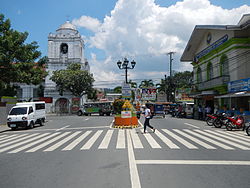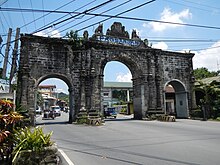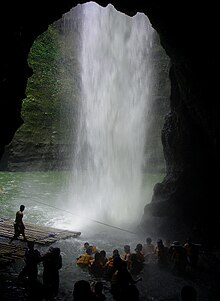Pagsanjan
- Not to be confused with Pagsanghan, one of the municipalities of the province of Western Samar in the Philippines.
This article needs additional citations for verification. (November 2013) |
Pagsanjan | |
|---|---|
| Municipality of Pagsanjan | |
 Downtown area | |
Nicknames:
| |
| Motto(s): Bayang Maunlad, Bayang Maganda, Bayang Payapa, Lahat ay Masaya | |
 Map of Laguna with Pagsanjan highlighted | |
Location within the Philippines | |
| Coordinates: 14°16′N 121°27′E / 14.27°N 121.45°E | |
| Country | |
| Region | Calabarzon |
| Province | Laguna |
| District | 4th District |
| Founded | December 12, 1668 |
| Barangays | 16 (see Barangays) |
| Government | |
| • Type | Sangguniang Bayan |
| • Mayor | Girlie "Maita" J. Ejercito (PMP) |
| • Electorate | 31,210 voters (2022) |
| Area | |
| • Total | 26.36 km2 (10.18 sq mi) |
| Population (2020 census)[3] | |
| • Total | 44,327 |
| • Density | 1,700/km2 (4,400/sq mi) |
| Time zone | UTC+8 (PST) |
| ZIP code | 4008 |
| PSGC | |
| IDD : area code | +63 (0)49 |
| Income class | 3rd municipal income class |
| Revenue (₱) | ₱ 190.6 million (2020) |
| Native languages | Tagalog |
| Website | www |
Pagsanjan, (pronounced Pag-sang-han), officially the Municipality of Pagsanjan, (Tagalog: Bayan ng Pagsanjan), is a 3rd class municipality in the province of Laguna, Philippines. According to the 2020 census, it has a population of 44,327 people.[3]
Situated about 92 kilometres (57 mi) southeast of Manila, Pagsanjan is the tourist capital of Laguna and the home of the Bangkero Festival. The bangkeros are tour guides, who steer the tourists' boats. They are the boatmen who shoot the 14 rapids between rocks and boulders all the way to the Pagsanjan Falls (or Magdapio Falls), for which the town is well known but are actually located in the neighboring municipality of Cavinti. The Bangkero Festival is celebrated in the month of March.
The incumbent mayor of Pagsanjan, Laguna is Girlie J. Ejercito, known as former actress Maita Sanchez. She is also the wife of Emilio Ramon "Jorge Estregan, Jr." Ejercito, who served as mayor from 2001–2010 and previous governor of Laguna.
For 170 years (1688–1858), Pagsanjan was the capital of the province of Laguna. During this long period, the town prospered as the commercial, cultural and learning center of the province, and was called the "Athens of Laguna".[4]
Etymology
Pagsanjan is located in the riparian delta formed by the confluence of the Balanac and Bumbungan rivers. Originally named Pinagsangahan, meaning "branching" or "juncture", the town was given renamed Pagsanjan by early Spanish colonists, because they found it extremely difficult to pronounce its polysyllabic name.
Geography
Pagsanjan has a land area of 26.4 square kilometres. It is located about 92 kilometres (57 mi) southeast of Manila. It is bounded on the east by the Balubad Mountain; on the west by the capital town of Santa Cruz; on the north by the San Isidro Hill and Laguna de Bay; on the north-east by the town of Lumban; on the southeast by the towns of Cavinti and Luisiana; on the south by Mount Banahaw; and on the south-west by the town of Magdalena.
Baraŋgays
Pagsanjan is politically subdivided into 16 barangays. [2]
History

Pagsanjan was originally a barrio of Lumban. In 1668, eight Japanese and Chinese traders who were highly impressed by the strategic location of the barrio at the juncture of Balanac and Bumbungan rivers founded the town. They established a trading settlement and engaged in the betelnut industry. In time, the barrio became the flourishing trading center of eastern Laguna and attracted families from the surrounding communities of Cavinti and Pila. On December 12, 1668, the then Governor, General Juan Manuel de la Peña Bonifaz, issued a gubernatorial decree elevating its status from barrio to a town. In 1688, Pagsanjan replaced Bay as the capital of the province. It remained such until 1858, during which it bloomed as the cultural and commercial center of the province.
Pagsanjan residents
Like all people in the world, the Pagsanjeños are hospitable and friendly to all visitors, especially the foreigners. They are warmhearted, fiesta-loving and witty. In time of peace, they are amiably peaceful, civic-spirited, and cheerful; in time of war, however, they are brave, intensely patriotic, and fight with fury. They are loyal and proud of their beloved town and ancestral heritage.
The people of Pagsanjan are also fortunate to have a resplendent cultural heritage. This culture is a harmonious blending of the Asian, Hispanic, Mexican, and American civilization influences. It is revealed in their rich folklore, customs and traditions, and colorful fiestas. During colonial times Pagsanjan was a famous center of culture. Her people, according to Fray Felix de la Huerta, Franciscan friar-chronicler, were "muy culto" (highly cultured). The Pagsanjeños then cherished good education. They sent their children to the elementary school to learn the fours R's (reading, writing, arithmetic, and religion). Children of the rich families studied in the homes of private teachers. After acquiring the fundamentals of Spanish and Latin languages, they were sent to Manila to obtain higher education at the Ateneo de Manila, College of San Juan de Letran, and in the University of Santo Tomas. It is a fact that during the Spanish regime Pagsanjan among all towns in Laguna had the highest percentage of illustrados (intellectuals).
This old tradition of acquiring a good education still exists among present-day Pagsanjeños. To them, a college diploma is a status symbol. Today numerous Pagsanjeños study law, medicine, education, nursing, engineering, and other college courses in the colleges and universities in Manila and in foreign countries.
As a cultured people, The Pagsanjeños take pride in their fine homes with beautiful furniture, oil paintings, pianos, and rugs; in their well-groomed lawns, and flower gardens; in their clean, beautiful streets, and sidewalks; and in their attire and personal appearance. But because of the destruction of their ancestral homes in Pagsanjan and the threat of the Huk movement in the towns and barrios of Laguna province, many Pagsanjeño families evacuated their native town and moved permanently to the Greater Manila area. This exodus of Pagsanjeño families mostly represented the elite of the local population, including rich landlords and the talented intellectuals. A few prominent families noted for their lineage and inherited wealth, however, remained in town and cooperated with the common people in the rebuilding of their ruined town.
The rich Pagsanjeño families who left the town resided in Manila, Pasay, Makati, Caloocan City, and San Juan, where they built their homes and reared their families. Some of them sold their ancestral residential lots in Pagsanjan, for they had no intention of restoring their old homes in town. They became absentee landlords, for they simply employed some persons called encargados to manage their family rice farms and coconut plantations.

Demographics
| Year | Pop. | ±% p.a. |
|---|---|---|
| 1903 | 6,361 | — |
| 1918 | 7,538 | +1.14% |
| 1939 | 8,865 | +0.78% |
| 1948 | 9,282 | +0.51% |
| 1960 | 10,691 | +1.18% |
| 1970 | 14,556 | +3.13% |
| 1975 | 16,188 | +2.15% |
| 1980 | 19,489 | +3.78% |
| 1990 | 25,024 | +2.53% |
| 1995 | 28,999 | +2.80% |
| 2000 | 32,622 | +2.56% |
| 2007 | 35,944 | +1.35% |
| 2010 | 39,313 | +3.31% |
| 2015 | 42,164 | +1.34% |
| Source: Philippine Statistics Authority[5][6][7][8] | ||
In the 2020 census, the population of Pagsanjan was 44,327 people,[3] with a density of 1,700 inhabitants per square kilometre or 4,400 inhabitants per square mile.
Notable Pagsanjeños
- Gregorio F. Zaide - famous historian and author, "Dean of Filipino Historiographers"
- Pedro Pelaez - educator, priest and is considered the "Father of Filipinization of the Church" and "The Godfather of the Philippine Revolution"
- Leandro H. Fernandez - educator, author and historian
- Francisco Benitez - First Dean of UP College of Education, educator and author, husband of Paz Marquez Benitez
- Vicente F. Fabella - educator, economist, civic leader and first Filipino certified public accountant
- Severino Taiño - Brigadier General, friend of Paciano Rizal
- Virginia Llamas - Queen of Manila Carnival in 1922 and wife of Carlos P. Romulo
- Emilio Ramon "Jorge Estregan, Jr." Ejercito a.k.a. ER Ejercito - actor and former governor of Laguna, famous for the movie Asiong Salonga and El Presidente
- Girlie "Maita" Javier Sanchez Ejercito - former actress, current mayor of Pagsanjan and wife of former Laguna Governor Jorge E.R. Ejercito III
- Joseph "Erap" Ejercito Estrada - originally born in Tondo, Manila but considered himself as a true son of Laguna because his ancestors originated in Pagsanjan
- Ernesto Maceda - former councilor of Manila, former senator, columnist and lawyer
- June Lazarte - a famous Filipino animal trainer who became famous for his dog named Saver
- Mario Montenegro - actor
- Abner Afuang - mediaman, former police officer and former mayor of Pagsanjan
- Louie Ignacio - TV director
Pagsanjan March
The official song of the Municipality of Pagsanjan and its people is Pagsanjan March. The anthem was composed by Rogel Taiño, a native of Pagsanjan.
See also
- Pagsanjan Falls
- Pagsanjan Arch
- Our Lady of Guadalupe Parish Church (Pagsanjan)
- Pagsanjan Municipal Hall
- Bumbungan River
- Battle of Pagsanjan
References
- ^ Municipality of Pagsanjan | (DILG)
- ^ a b "Province: Laguna". PSGC Interactive. Quezon City, Philippines: Philippine Statistics Authority. Retrieved 12 November 2016.
- ^ a b c Census of Population (2020). "Region IV-A (Calabarzon)". Total Population by Province, City, Municipality and Barangay. Philippine Statistics Authority. Retrieved 8 July 2021.
- ^ Pagsanjan Official Site Archived 2011-07-27 at the Wayback Machine
- ^ Census of Population (2015). "Region IV-A (Calabarzon)". Total Population by Province, City, Municipality and Barangay. Philippine Statistics Authority. Retrieved 20 June 2016.
- ^ Census of Population and Housing (2010). "Region IV-A (Calabarzon)" (PDF). Total Population by Province, City, Municipality and Barangay. National Statistics Office. Retrieved 29 June 2016.
- ^ Censuses of Population (1903–2007). "Region IV-A (Calabarzon)". Table 1. Population Enumerated in Various Censuses by Province/Highly Urbanized City: 1903 to 2007. National Statistics Office.
{{cite encyclopedia}}: CS1 maint: numeric names: authors list (link) - ^ "Province of Laguna". Municipality Population Data. Local Water Utilities Administration Research Division. Retrieved 17 December 2016.



